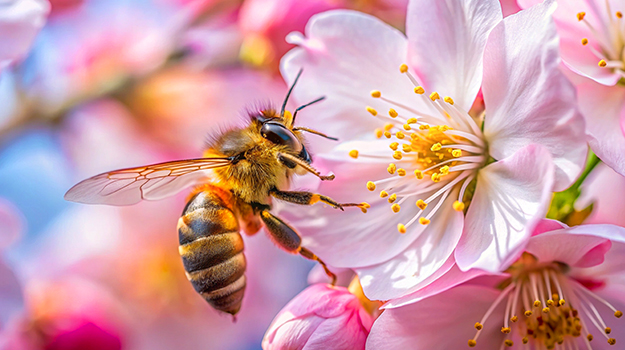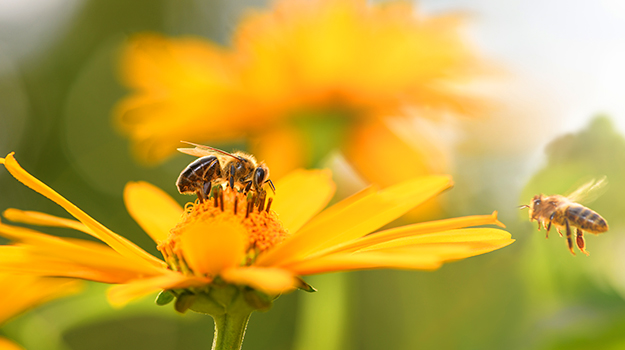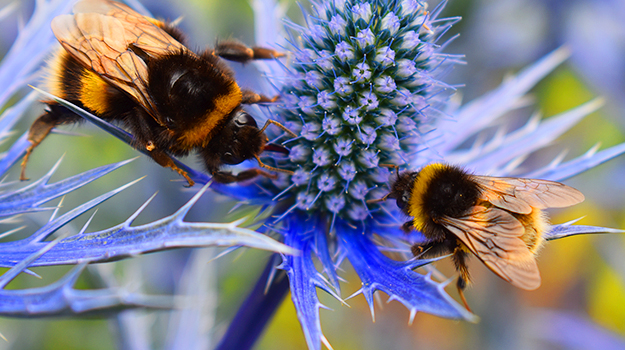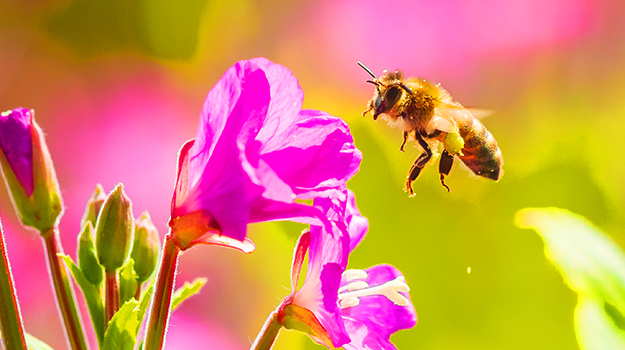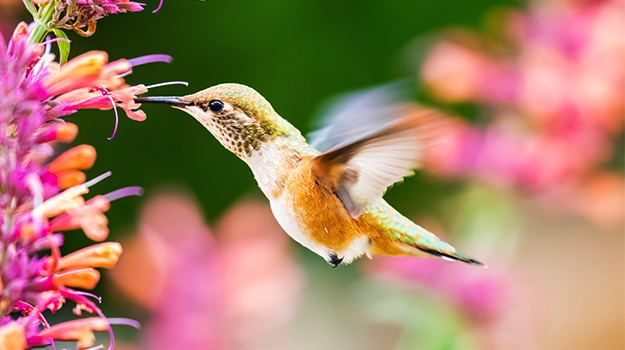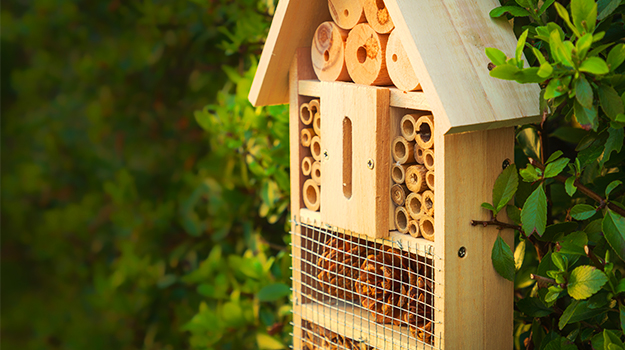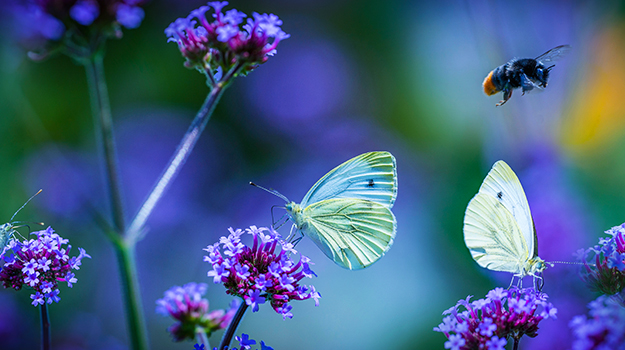TABLE OF CONTENTS
- What is pollination?
- Why are bees important?
- What is the biggest threat to native bees?
- How to support bees in your garden?
What is pollination?
You surely remember the story of the birds and the bees? Pollination occurs when the male part (pollen) from one flower is moved to the female part (stigma) in another flower of the same species. Just like that, you have a successful pollination, one that produces fertile seeds. 90% of flowering plants need to be pollinated. Although a few are considered self-pollinating, most plants are pollinated by birds, bees, butterflies, other insects, wind and/or water.
These pollinators provide their pollination services to several hundred thousand plant species and over a thousand crops. The production of foods like blueberries, apples, cherries, squash and tomatoes depends mostly on pollinating insects, and to a lesser extent, on wind.
Why are bees important?
In 2021, Agriculture and Agri-Food Canada estimated that the total annual economic contribution of honey bee pollination through direct additional harvest value was about $3.18 billion. When the estimated contribution of honey bee pollination to the production of hybrid canola seed is added, the total estimated contribution rises to $7 billion per year.
Bees are one of the most important pollinators. Bees feed on and require both nectar and pollen. The sweet liquid nectar is for energy and honey production, and the pollen provides protein and other nutrients for the bee colony. The bees travel from flower to flower with small amounts of pollen, rubbing off their bodies and depositing them on other flowers that they visit, resulting in cross-pollination. Other pollinators, such as butterflies, flies, beetles and hummingbirds, go for the nectar but may only inadvertently contact the pollen.
The fact that bees both collect and transfer pollen makes them more useful than the other pollinators that gather nectar only. Even so, these other pollinators are still valuable.
What is the biggest threat to native bees?
Our native insect pollinator population is in decline. These pollinators include solitary bees, bumblebees, wasps, hover flies, butterflies, moths, flies and beetles. Recent studies implicate various causes for this decline: loss of habitat and habitat fragmentation, urban development, pesticide use, environmental pollution and disease. Because of climate change, there is also an encroachment of new invasive and more aggressive insects migrating from the south, forcing some native pollinators out of their natural habitat.
How to support bees in your garden?
Yes, you can help by providing natural foraging and nesting areas. Native bees and butterflies are attracted to specific colours: bees like blue, violet, purple, white and yellow flowers, while butterflies look for red, orange, yellow and pink-purple blossoms. You want a sequence of bright-coloured and fragrant blooms from spring to fall.
Here’s what you can do…
Plant native plants
According to pollinator experts, native plants are 3-4 times more likely to attract native pollinators. Don’t worry, as they will still visit non-native plants, but would prefer flowers that they were always accustomed to.
Strive for continuous food supply all season
Provide plants that will overlap bloom times so that there is always a series of flowers blooming as the season transitions.
If the colony faces a shortage of nectar or extreme heat, you can give bees a homemade mix of water and sugar or a ready-to-use syrup that will meet their needs when times are more difficult.
Get the recipe here.
Arrange similar plants in a clump
It is easier for pollinators to find your food supply if it is in a big clump, instead of a single lonely flower!
Use our plan to create a superb arrangement with plants that are particularly appreciated by pollinators.
Consider the pollinators’ favourite colours, shapes and scents
There is a very useful website for what to plant in your specific area: Planting Guides | Pollinator.org. Simply put in your postal code in the Canadian part and get a list of pollinator plants in your region. Scroll to the last pages for the complete list.
Here is another good address to discover what to plant region by region if you live in the United States: Pollinator-Friendly Native Plant Lists | Xerces Society
Use plants of different heights
Arrange a layered canopy of trees, shrubs, vines and plants with descending heights. Taller plants at the back!
Offer protected patches
Plantings should be along rocks or stone walls to give pollinators a place to settle. Have shrubs and tall grasses nearby to protect them from the elements and from predators.
Some pollinators are specialists
A small percentage only feed from one or two kinds of plants. They have developed specialized behaviours or body parts for specific plants. Adult monarchs, for example, will feed on the nectar of many flowers, but they breed only where milkweeds occur. The leaves of the milkweed are the sole food of the larvae, or caterpillars, that emerge from the eggs.
Avoid tilling the soil in some areas
Most native bees and bumblebees nest in the ground, on south-facing, well-drained areas with sandy soil. If it’s possible, create a friendly space for them by avoiding disturbing that area of your garden.
Expand your garden beds to attract pollinators
If you have some unused areas of your lawn, consider turning them into pollinator gardens. If you don’t want a full-fledged garden, consider using native groundcovers to replace some lawn areas.
Provide water to bees
A birdbath in the garden or some containers of shallow water should be available for all pollinators. Keep it fresh. You would be surprised at how much they appreciate sipping water. If the water level is too deep, add some rocks in the centre to give the insects a place to stand when they drink.
Learn how to create a water station for bees and butterflies here: Watering station for bees
Add a bee house in your garden
These are available online or at garden centres. It is designed to attract solitary bees (bees that do not live in colonies). Each female will make her own nest in natural or artificial tunnels. Face it south on a solid post 1-2 metres off the ground.
Learn how to build a bee house here: Bee Houses for Native Solitary Bees | The Old Farmer's Almanac
Be a fall lazy gardener
In the fall, avoid cutting back your garden or uprooting annuals. Many butterflies and moths spend the winter as cocoons attached to plant stems. Some native bee larvae will overwinter inside hollow stems or other cavities. Don’t cut back your garden until later the next spring. If you do cut back, prune so 30 cm (1 ft.) of stems are still standing, and leave any cut stems on the ground until spring.

